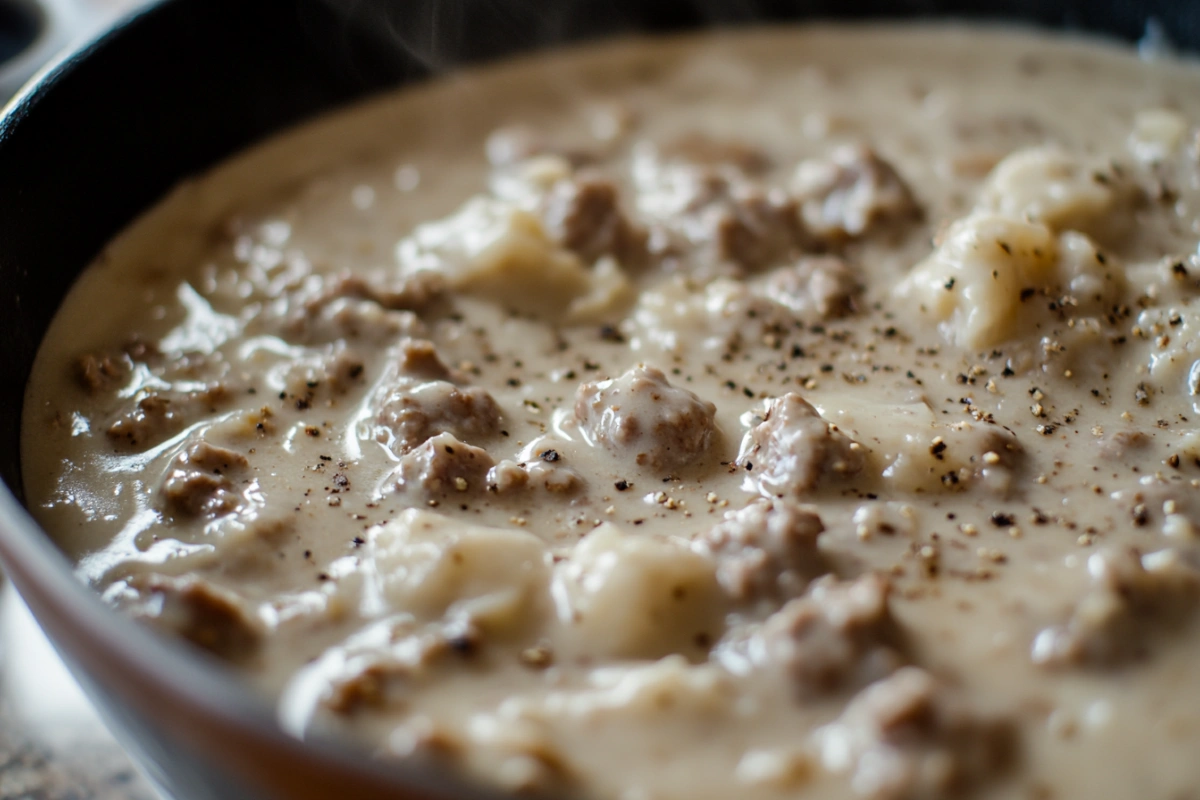Sausage gravy, a staple in Southern cuisine, is more than just a dish; it’s a comforting experience that warms the soul. Whether served over fluffy biscuits, creamy mashed potatoes, or even grits, this savory delight brings a burst of flavor to any breakfast or brunch. But what exactly is sausage gravy made of? In this article, we’ll dive deep into its ingredients, variations, and preparation, ensuring you have all the information you need to whip up the best sausage gravy recipe at home.
1. Introduction
Sausage gravy is beloved across many kitchens, especially in the South, where it’s a breakfast must-have. But what makes this dish so appealing? It’s the combination of rich, flavorful sausage and a creamy, savory sauce that tantalizes taste buds and evokes feelings of home. Let’s explore what sausage gravy is, what it’s made of, and how you can make this classic dish a part of your culinary repertoire.
2. What is Sausage Gravy?
So, what exactly is sausage gravy? At its core, it’s a type of white gravy made by combining cooked sausage with a roux (a mix of fat and flour) and milk. This blend creates a thick, hearty sauce that’s perfect for pouring over warm biscuits or serving alongside other breakfast favorites.
The gravy’s flavor is primarily derived from the sausage, which can be seasoned in various ways. This means that each recipe can have its unique twist, whether it’s spicy, herby, or even a little smoky. Typically, this dish boasts a creamy texture and a peppery kick that leaves you wanting more.
Interestingly, the origins of sausage gravy trace back to the Southern United States, where hearty breakfasts were a necessity for hardworking folks. Over time, it’s evolved into a beloved dish enjoyed by many, regardless of the time of day.
3. Key Ingredients of Sausage Gravy Recipe
To truly understand what makes sausage gravy so delicious, we need to break down its key ingredients. Each component plays a significant role in creating that beloved creamy texture and savory flavor. Let’s take a closer look at what goes into this classic dish.
Sausage Meat
First and foremost, we have the sausage meat. Typically, breakfast sausage is the go-to choice for making sausage gravy. This type of sausage is usually ground pork mixed with various seasonings. Depending on the brand or recipe, you might find it seasoned with herbs, spices, or even a hint of sweetness. The fat content in the sausage is crucial; it adds richness to the gravy while also providing a base for the roux.
You can also explore different sausage varieties, such as country sausage, which tends to be coarser and packed with robust flavors. Some adventurous cooks even opt for turkey or chicken sausage as a healthier alternative, but the traditional pork sausage remains the most popular choice
Thickening Agent: Flour
Next up is flour, which acts as the thickening agent in sausage gravy. The typical method involves using all-purpose flour, which helps create a roux when combined with the rendered fat from the cooked sausage. This roux is vital; it forms the base of the gravy, ensuring it has that creamy, luscious texture we all crave.
To achieve the perfect consistency, you’ll want to cook the flour for a couple of minutes to eliminate any raw taste. While all-purpose flour is standard, you might find recipes that use cornstarch or other gluten-free flours as substitutes. However, they will yield a different flavor and texture
Liquid Base: Milk
Of course, no sausage gravy would be complete without its liquid base: milk. The most commonly used type is whole milk, which contributes to a rich, creamy sauce. However, feel free to experiment with other dairy options, such as 2% milk or even half-and-half, for a creamier texture.
For those who prefer dairy-free alternatives, plant-based milk like almond or oat milk can be substituted. Just keep in mind that the flavor profile will change slightly, so choose your alternative wisely! The liquid also helps balance the richness of the sausage and flour, ensuring a well-rounded dish
Seasonings
Finally, we can’t forget about the seasonings that elevate sausage gravy from ordinary to extraordinary. The primary seasoning is, of course, black pepper. It adds a delightful kick and is often used generously.
Other common seasonings include garlic powder, onion powder, and seasoned salt. For those who like a little heat, feel free to sprinkle in some cayenne pepper or red pepper flakes. These additions can really bring the gravy to life, allowing you to customize the flavor to your liking

4. Variations of Sausage Gravy Recipe
Sausage gravy isn’t just a one-size-fits-all dish. It boasts a variety of styles and adaptations that cater to different tastes and dietary preferences. Let’s dive into some of the most popular variations that can enhance your breakfast table!
Regional Variations
When it comes to sausage gravy, the region you’re in can make a big difference. In the South, the classic version often leans heavily on pork sausage and a generous amount of black pepper. However, if you travel to the Midwest, you might find unique twists, such as the inclusion of cream cheese or cheddar for added richness.
In some areas, particularly in parts of the Southwest, you may come across sausage gravy that incorporates jalapeños or other spicy elements. These regional variations highlight how adaptable this dish can be, allowing you to explore a world of flavors while sticking to its comforting roots
Healthier Options
If you’re looking for a healthier version of sausage gravy, consider substituting the traditional pork sausage with turkey or chicken sausage. These leaner options can significantly reduce the calorie count without sacrificing too much flavor.
You can also make it lighter by using low-fat or plant-based milk instead of whole milk. Additionally, using whole wheat flour instead of all-purpose flour can boost the nutritional profile. This way, you can enjoy your sausage gravy while still sticking to your health goals .
Specialty Sausage Gravy Recipe
For those wanting to get a bit creative, specialty sausage gravy recipes can offer a fun twist. Some cooks love adding ingredients like spinach, mushrooms, or even sun-dried tomatoes for a gourmet touch. These additions not only enhance the flavor but also add nutritional benefits.
Another popular variation is a cheesy sausage gravy, where you can mix in cream cheese or shredded cheese, creating a decadent, creamy sauce that’s hard to resist. This approach can elevate your sausage gravy to new heights, making it a star at any breakfast or brunch gathering

5. How to Make Sausage Gravy Recipe
Now that we’ve explored the variations, let’s get down to business: how to actually prepare a delicious batch of sausage gravy!
Step-by-Step Guide
- Cook the Sausage: In a large skillet, over medium heat, crumble the sausage and cook it until it’s browned and fully cooked. The fat rendered from the sausage will serve as the base for your gravy.
- Make the Roux: Once the sausage is cooked, sprinkle the flour over the sausage and mix it well. Cook this mixture for about 2 minutes, allowing the flour to absorb the fat and cook through. This step is essential to prevent the raw flour taste from sneaking into your gravy.
- Add Milk: Gradually pour in the milk while stirring continuously. This helps prevent lumps from forming. Keep stirring until the mixture thickens, which usually takes about 5-10 minutes.
- Season: Finally, season your gravy with black pepper, and any other spices you fancy, tasting as you go to find that perfect balance.
- Serve: Once your sausage gravy reaches your desired thickness, it’s ready to be served! Pour it generously over biscuits, mashed potatoes, or any other breakfast item you love.
Tips for Perfecting the Consistency and Flavor
- For a thicker gravy, add a bit more flour or reduce the amount of milk.
- If your gravy is too thick, simply stir in a bit more milk until you achieve the desired consistency.
- Adjust the seasonings to your liking. If you prefer a spicier kick, don’t be shy with the black pepper or even add some cayenne pepper
Common Mistakes to Avoid
- Not Cooking the Flour Enough: This can lead to a raw taste in the gravy.
- Skipping Seasoning: Don’t forget to taste and adjust the seasoning! A pinch of salt or a dash of pepper can make a world of difference.
- Overcooking the Sausage: While you want it browned, be careful not to dry it out. The fat is what gives your gravy flavor, after all!
6. Serving Suggestions
Now that you’ve mastered the art of making sausage gravy, it’s time to think about how to serve it. This dish is incredibly versatile and pairs well with a variety of sides. Let’s explore some delightful serving suggestions that will elevate your breakfast or brunch experience!
Classic Pairings
The most traditional way to enjoy sausage gravy is over freshly baked biscuits. The fluffy, buttery biscuits soak up the rich gravy, creating a mouthwatering combination that’s hard to beat. Whether you opt for homemade biscuits or store-bought, the result is a comforting dish that many people associate with Sunday mornings.
For a heartier meal, consider serving sausage gravy over mashed potatoes. This twist gives you a warm, filling dish that’s perfect for any time of the day, not just breakfast! It’s especially satisfying during colder months when you crave something cozy.
Creative Alternatives
Feeling adventurous? Try using sausage gravy as a topping for grits. The creamy, cheesy goodness of grits combined with the rich flavors of the gravy creates a Southern classic that will leave everyone raving.
If you’re looking to mix it up, consider pouring sausage gravy over hash browns or eggs. These options allow you to experiment and find what works best for your palate. You might even try a breakfast burrito, wrapping the gravy, sausage, and some scrambled eggs in a tortilla for a delicious handheld option.
Lastly, don’t shy away from serving it alongside pancakes or waffles! The sweet and savory combination can be quite delightful and is sure to surprise your taste buds

7. Storage and Reheating Tips
Now that you know how to serve sausage gravy, let’s discuss what to do with any leftovers. Proper storage and reheating can help maintain its flavor and texture.
How to Store Leftover Sausage Gravy
Once you’ve enjoyed your meal, allow the sausage gravy to cool down to room temperature. Then, transfer it to an airtight container and store it in the refrigerator. Ideally, it should be consumed within three to four days to ensure the best flavor and safety
For longer storage, you can freeze sausage gravy. Pour it into a freezer-safe container or a heavy-duty freezer bag, leaving some space for expansion. When properly stored, it can last for up to three months in the freezer. Just remember to label the container with the date!
Best Methods for Reheating
When it’s time to enjoy your leftover sausage gravy, there are a couple of effective methods for reheating:
- Stovetop: Pour the gravy into a saucepan and heat it over low to medium heat. Stir it frequently to ensure it heats evenly. If the gravy is too thick, you can add a splash of milk to restore its creamy texture.
- Microwave: If you’re in a hurry, you can use the microwave. Place the gravy in a microwave-safe bowl, cover it with a microwave-safe lid or plate, and heat it in short intervals, stirring in between. This method might not give you the same texture as the stovetop but is quick and convenient.
8. Common Questions About Sausage Gravy
As we dive into the world of sausage gravy, it’s common to have a few questions about this beloved dish. Here, we address some of the most frequently asked questions to help you navigate your sausage gravy journey.
What kind of sausage is best for sausage gravy?
While you can use various types of sausage, breakfast sausage is typically preferred for its flavor and fat content. Ground pork sausage is the traditional choice, but you can also experiment with turkey or chicken sausage for a lighter version. Some recipes even suggest using Italian sausage for a different flavor profile
Can I make sausage gravy ahead of time?
Absolutely! You can prepare sausage gravy ahead of time. Just store it in the refrigerator after it has cooled, and it should last for about three to four days. If you plan to freeze it, make sure to use a freezer-safe container. When you’re ready to enjoy it, simply reheat it on the stovetop or in the microwave, adding a little milk if it’s too thick
Can I make sausage gravy without flour?
Yes, you can make sausage gravy without flour by using alternatives like cornstarch or gluten-free flour blends. Just remember that these substitutions may alter the texture and flavor slightly. If you’re aiming for a low-carb option, some people use almond flour or coconut flour as substitutes, but this can change the overall taste and consistency
How do I make my sausage gravy spicier?
To spice things up, consider adding more black pepper or incorporating cayenne pepper or red pepper flakes. These ingredients can give your gravy a delightful kick. Additionally, using spicy sausage or adding ingredients like diced jalapeños can enhance the heat
What can I serve with sausage gravy?
Sausage gravy is incredibly versatile! The classic pairing is with biscuits, but it also works wonderfully over mashed potatoes, grits, or even hash browns. You can also serve it with eggs or use it as a topping for breakfast burritos
Conclusion: Embracing the Comfort of Sausage Gravy
In summary, sausage gravy is a beloved dish that embodies comfort food at its finest. From its simple yet flavorful ingredients—savory sausage, creamy milk, and hearty flour—to the various regional and creative adaptations, there’s something for everyone to enjoy. Whether you prefer the classic pairing with biscuits or want to experiment with unique side dishes, the versatility of this dish is truly remarkable.
We’ve explored how to make sausage gravy, different variations you can try, and the best ways to serve and store it. Plus, we addressed common questions to help you navigate the nuances of this timeless recipe.
Whether you’re whipping it up for a cozy breakfast at home or serving it at a gathering, sausage gravy is sure to delight. So, roll up your sleeves, gather your ingredients, and embrace the rich flavors of this classic dish. Your taste buds will thank you!

